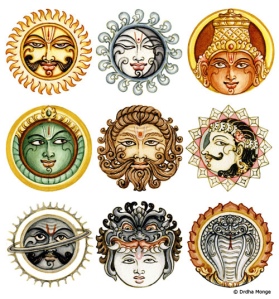Om – Tat – Sat, Sat-Chit-Ananda, Satyam Shivam Sundaram, Sama Beda Danda, are all simple abstract concepts that exist in many a Hindu household, and are often practiced as a way of life, without much fanfare. Each simple concept of Hinduism can be expanded into a whole new way of life. For example, the concept of Om – Tat – Sat – which a Hindu simply states as his morning prayer in abstract terms, corresponds with the Holy Ghost, God the Son, and God the Father in the Christian scriptures. And according to the expansion of the consciousness of a person, he experiences these concepts, is the belief. The religion itself, is like a river – It just flows – it is used just as the user deems – to wash oneself, or to swim, or to catch fish – the river itself, remains unaffected.
One of the finest aspects of Hinduism is that there would be different interpretations to a single concept and each one would throw light on a different perspective. For example, there are many interpretations/significance attributed to different parts of a temple. The pond in the temple is said to denote the mind – unless the mind is clear, it cannot reflect the divinity within – if the mind is distorted like the water with ripples, it cannot reflect the divinity. The sanctum sanctorum is said to be the heart of the temple, where you feel love for God. The temple towers are related to the spine in the human body – the windows/doors in the towers denote the various chakras in the spine. Like this, the allegories are endless. Different schools of thought look at these aspects in a comprehensive manner.
However, nothing ever comes close to the abstraction of the planetary worship done in Hindu temples. Karmic compulsions force humans to undergo many trials – to temporarily negate or escape the invisible forces and pulls of the planets, the ancient Hindus discovered many ritualistic shortcuts, one of which is the worshipping of the navagrahas – Each planet is ruled by a God or Goddess, and worshipping them brings permanent or temporary relief to the worshipper. The ancient Hindus discovered that Karma (Prarabda Karma and Sanchita Karma – Karma is again a very huge topic – some say that some Karma cannot be changed, whilst some Karma can be changed with God’s Grace) does not affect the person who has expanded his consciousness to encompass the star/moon and planets that affect him. Accordingly, they arranged the images of the Sun God, the Moon God, Saturn, Jupiter, etc etc. (The nine Gods worshipped are – Sani, Chandra, Surya, Rahu, Ketu, Shukra, Bhudan, Sevvai and Guru) and when a person ritualistically circumambulates the images, he /she is said to have expanded his/her consciousness to encompass these celestial bodies, and hence, freed from their compelling influence. But as told earlier, the important thing is to understand these symbols, rituals and customs in the right perspective. The flexibility of Hinduism allows these concepts to be interpreted in different ways by different people at different times.
( To be continued)
